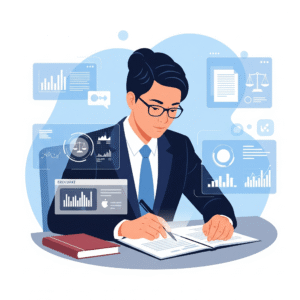Data is everywhere. It’s in our sales reports, our social media feeds, and our customer support tickets. However, having a lot of data doesn’t automatically mean you have answers. In fact, without a way to make sense of it all, that data is just noise. This is where AI in Analytics & Insights comes in, transforming mountains of information into actionable business intelligence.
For years, businesses relied on human analysts to manually sift through spreadsheets and create reports, but that approach is no longer scalable. In 2025, the competitive edge belongs to companies that can not only collect data but also use artificial intelligence for analytics & insights strategies to understand it instantly. It’s a fundamental shift from simply knowing “what happened” to predicting “what will happen” and even prescribing “what you should do about it.” This blog post will show you how AI in Analytics & Insights is changing everything, with real-world examples and practical steps you can take today.
From Retrospective to Predictive: The Evolution of Analytics
Traditionally, business analytics has been a backward-looking process. We’d review last month’s sales, last quarter’s web traffic, and last year’s customer churn. This descriptive approach tells us about the past, but it doesn’t prepare us for the future. Consequently, businesses were constantly reacting to market changes rather than anticipating them.
Thanks to the rise of AI in Analytics & Insights, that is all changing. Artificial intelligence can process historical data at an incredible speed and scale, uncovering patterns that are invisible to the human eye. These patterns allow AI models to perform predictive analytics, forecasting future trends with remarkable accuracy. This new level of insight is becoming an indispensable part of artificial intelligence for analytics & insights strategies for companies of all sizes. They can now forecast customer demand, anticipate supply chain disruptions, and identify potential risks before they become a problem.
Harnessing AI in Analytics & Insights: Beyond the Dashboard
Most of us are familiar with business intelligence (BI) tools that display data on colorful dashboards. These tools are fantastic, but they often require a skilled analyst to interpret the numbers and find meaningful connections. When you infuse these tools with AI in Analytics & Insights, the dashboard doesn’t just show you data; it tells you a story.
AI-driven analytics platforms use machine learning to proactively identify anomalies and opportunities. For instance, an AI might automatically flag a sudden drop in a key performance indicator (KPI) and then use a variety of data sources to explain the potential cause. It could also suggest a solution based on similar past events. This augmented analytics approach frees up a data analyst’s time, allowing them to focus on high-level strategic thinking rather than routine data exploration. Therefore, businesses are empowered to make faster, smarter, and more data-driven decisions every single day.
Real-World Triumphs: Case Studies in AI Analytics
The impact of AI in Analytics & Insights is best illustrated through real-world applications. These examples show how a smart strategy can lead to significant and measurable outcomes.
Case Study 1: The Retail Giant and Predictive Inventory
A major retail company faced a common challenge: managing inventory across hundreds of stores. Overstocking led to wasted capital and markdowns, while understocking meant missed sales and frustrated customers. To solve this, they implemented an AI system that analyzed a variety of factors, including local weather forecasts, social media trends, regional event schedules, and historical sales data.
The system’s predictive analytics helped the company forecast demand for specific products at individual store locations with a much higher degree of accuracy. As a result, they were able to optimize their supply chain and ensure the right products were on the right shelves at the right time. This strategic use of AI in Analytics & Insights led to a 15% reduction in inventory waste and a 10% increase in sales from improved product availability.
Case Study 2: A Financial Institution’s Fraud Detection
Fraud detection is a race against time, and traditional, rule-based systems often fail to keep up with sophisticated criminals. A large financial institution integrated a machine learning-based system into its transaction monitoring process. Instead of simply flagging transactions that met a certain dollar amount or location, the AI system learned to identify fraudulent patterns by analyzing thousands of variables in real time.
The system could detect subtle anomalies in a customer’s spending behavior, such as a purchase made in a different country minutes after one in their home city. The use of AI in Analytics & Insights allowed the bank to flag potential fraud with an accuracy that was previously impossible. This led to a 75% reduction in false positives and a 50% increase in the speed of detecting and preventing actual fraud, saving millions of dollars annually.
Essential Tools for AI in Analytics & Insights Strategies
Getting started with AI analytics can seem daunting, but today’s tools make it more accessible than ever. Here are a few top recommendations:
- Tableau: A leading data visualization platform, Tableau now includes AI and machine learning features that assist with data preparation and automated explanations for your charts and graphs.
- Microsoft Power BI: This popular BI tool, deeply integrated with the Microsoft ecosystem, offers AI-driven features that can automatically find key influencers in your data and provide natural language queries.
- Databricks: Databricks provides a unified platform for data, analytics, and AI. Its “AI/BI Genie” allows users to get instant answers to critical business questions using natural language, making analytics accessible to everyone.
- Looker: Now part of Google Cloud, Looker’s platform provides a robust semantic layer for consistent data definitions and includes an AI assistant to help with the creation of reports and visualizations.
These tools represent a new wave of business intelligence, where the software doesn’t just show you data, but actively helps you understand it.
Beginner’s Guide: How to Start with AI in Analytics & Insights
Implementing AI in Analytics & Insights doesn’t require a complete overhaul of your business. You can start with a few simple, actionable steps.
- Start with a Single, Specific Problem: Don’t try to solve all your business challenges at once. Instead, focus on a single question. For example, “What’s the biggest factor driving customer churn?” or “Which marketing channel has the highest ROI?” This focused approach makes it easier to measure success and learn how to leverage your AI tools.
- Ensure Your Data is Clean and Connected: The old saying “garbage in, garbage out” is especially true for AI. Make sure your data is accurate, consistent, and organized. The more structured your data is, the better the AI can learn from it and deliver reliable insights.
- Train Your Team: AI isn’t just a tool; it’s a new way of working. Train your team members on how to use the new AI-powered features in your analytics platforms. Encourage them to experiment and ask questions of the data, as this will help them unlock new opportunities.
- Embrace Augmented Analytics: Most modern BI platforms, like the ones mentioned above, come with AI features built-in. Start by using these to generate automated insights and suggestions. You don’t need a custom machine learning model to get started; you just need to start with the tools you already have.
By following these steps, you can begin to integrate artificial intelligence for analytics & insights strategies into your daily workflow, unlocking new value and gaining a competitive advantage.
The Human Future: Why Your Role is More Important Than Ever
With AI handling the heavy lifting of data analysis, what’s left for us? The answer, as a recent HubSpot article points out, is that the human role is elevated. Rather than spending time on tedious data entry and report generation, professionals can focus on strategic thinking, creative problem-solving, and interpreting the “why” behind the AI’s findings.
A McKinsey report on the future of strategy development highlights this perfectly. AI will not replace the human strategist, but rather will become a crucial assistant that accelerates research and insight generation. The most successful professionals in this new era will be those who can ask the right questions of the data and translate the AI’s complex findings into actionable business strategies. The future of analytics is a partnership between human curiosity and machine intelligence.
The Future is Now: AI in Email Marketing in 2025
Conclusion: The Age of Intelligent Business
The integration of AI in Analytics & Insights is more than just a technological upgrade; it’s a paradigm shift for business. It empowers us to move beyond simply reacting to data and instead to proactively shape our future. By embracing artificial intelligence for analytics & insights strategies, you can transform your raw data into a powerful source of competitive advantage, drive unprecedented efficiency, and unlock opportunities that were once out of reach.
(AI for HR Managers) Is AI A Nightmare for HR Managers?
The time for waiting is over. The future of data-driven business is here, and it’s powered by AI.
Keyword List: AI in Analytics & Insights, Artificial Intelligence for Analytics & Insights strategies, AI-driven analytics, machine learning for data analysis, predictive intelligence, augmented analytics, business intelligence tools, data-driven decisions, AI tools



